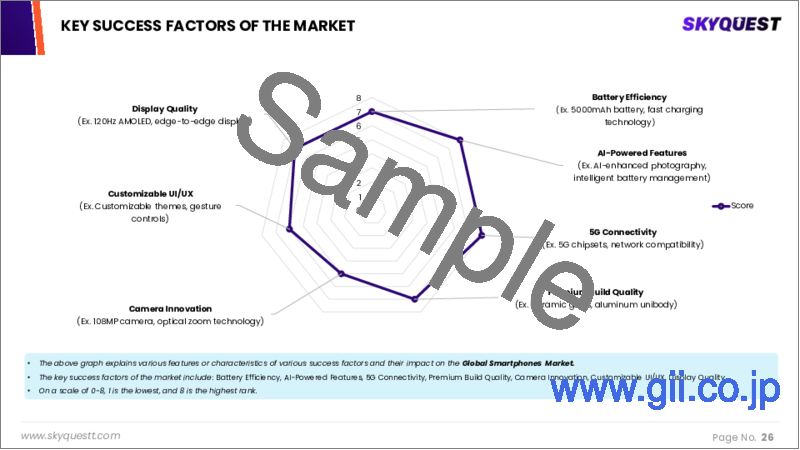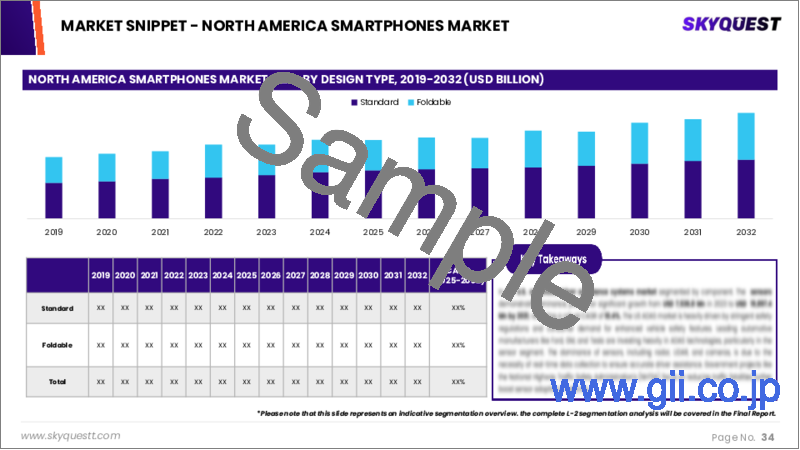|
|
市場調査レポート
商品コード
1636851
スマートフォンの市場規模、シェア、成長分析:オペレーティングシステム別、価格帯別、流通チャネル別、地域別 - 産業予測 2025~2032年Smartphones Market Size, Share, Growth Analysis, By Operating System (Android, iOS), By Price Range (Low-range Smartphones (Below $200), Mid-range Smartphones ($200-$500)), By Distribution Channel, By Region - Industry Forecast 2025-2032 |
||||||
|
|||||||
| スマートフォンの市場規模、シェア、成長分析:オペレーティングシステム別、価格帯別、流通チャネル別、地域別 - 産業予測 2025~2032年 |
|
出版日: 2025年01月15日
発行: SkyQuest
ページ情報: 英文 292 Pages
納期: 3~5営業日
|
全表示
- 概要
- 目次
スマートフォンの世界市場規模は、2023年に6,078億米ドルと評価され、2024年の6,491億3,000万米ドルから2032年には1兆987億6,000万米ドルに成長し、予測期間中(2025年~2032年)のCAGRは6.8%で成長する見通しです。
世界のスマートフォン市場は、特に労働者の間でeコマースとmコマースの傾向が高まっていることを背景に、大幅な成長が見込まれています。この動向を後押ししている主な要因としては、インターネットへのアクセス環境の向上、スマートフォン・メーカーの強力なマーケティング戦略、ソーシャルメディアの利用急増などが挙げられます。COVID-19パンデミックの経済的影響により、低予算で購入できるスマートフォンへの需要が高まりました。しかし、可処分所得が増加するにつれて、消費者はメディア、エンターテインメント、ネットワーキング、モバイル・コミュニケーションにより投資するようになり、スマートフォン、タブレット、ノートパソコン、ゲーム機などのコンシューマー・エレクトロニクスに大きな販売機会が生まれる可能性が高いです。さらに、Apple、Samsung、Huaweiのような主要ブランドがエネルギー効率の高いスマートフォンAIプロセッサを導入するなど、高度な人工知能(AI)技術の統合が、この競合情勢における需要をさらに増幅させています。
目次
イントロダクション
- 調査の目的
- 調査範囲
- 定義
調査手法
- 情報調達
- 二次データと一次データの方法
- 市場規模予測
- 市場の前提条件と制限
エグゼクティブサマリー
- 世界市場の見通し
- 供給と需要の動向分析
- セグメント別機会分析
市場力学と見通し
- 市場概要
- 市場規模
- 市場力学
- 促進要因と機会
- 抑制要因と課題
- ポーターの分析
主な市場の考察
- 重要成功要因
- 競合の程度
- 主な投資機会
- 市場エコシステム
- 市場の魅力指数(2024年)
- PESTEL分析
- マクロ経済指標
- バリューチェーン分析
- 価格分析
- 技術分析
スマートフォン市場規模:オペレーティングシステム別
- 市場概要
- アンドロイド
- iOS
- ウィンドウズ
- その他
- リナックス
スマートフォン市場規模:価格帯別
- 市場概要
- 低価格スマートフォン(200ドル以下)
- 中価格帯スマートフォン(200~500ドル)
- プレミアムスマートフォン(500ドル以上)
スマートフォン市場規模:流通チャネル別
- 市場概要
- OEMストア
- 小売業者
- eコマース
スマートフォン市場規模
- 北米
- 米国
- カナダ
- 欧州
- ドイツ
- スペイン
- フランス
- 英国
- イタリア
- その他欧州地域
- アジア太平洋地域
- 中国
- インド
- 日本
- 韓国
- その他アジア太平洋地域
- ラテンアメリカ
- ブラジル
- その他ラテンアメリカ地域
- 中東・アフリカ
- GCC諸国
- 南アフリカ
- その他中東・アフリカ
競合情報
- 上位5社の比較
- 主要企業の市場ポジショニング(2024年)
- 主な市場企業が採用した戦略
- 市場の最近の動向
- 企業の市場シェア分析(2024年)
- 主要企業の企業プロファイル
- 会社概要
- 製品ポートフォリオ分析
- セグメント別シェア分析
- 収益の前年比比較(2022~2024年)
主要企業プロファイル
- Apple Inc.(United States)
- Samsung Electronics Co., Ltd.(South Korea)
- Xiaomi Corporation(China)
- Vivo Communication Technology Co. Ltd.(China)
- Oppo Mobile Telecommunications Corp., Ltd.(China)
- Huawei Technologies Co., Ltd.(China)
- Transsion Holdings(China)
- Sony Corporation(Japan)
- Lenovo Group Limited(China)
- ASUSTeK Computer Inc.(Taiwan)
- ZTE Corporation(China)
- Nokia Corporation(Finland)
- Google LLC(United States)
- LG Electronics Inc.(South Korea)
- HTC Corporation(Taiwan)
- Micromax Informatics(India)
- Realme(China)
- OnePlus Technology Co., Ltd.(China)
- TCL Technology(China)
- Panasonic Corporation(Japan)
結論と推奨事項
Global Smartphones Market size was valued at USD 607.8 billion in 2023 and is poised to grow from USD 649.13 billion in 2024 to USD 1098.76 billion by 2032, growing at a CAGR of 6.8% during the forecast period (2025-2032).
The global smartphone market is poised for substantial growth, driven by the rising trend of e-Commerce and m-Commerce, especially among the workforce. Key factors propelling this trend include increased internet accessibility, robust marketing strategies from smartphone manufacturers, and a surge in social media usage. The economic impact of the COVID-19 pandemic led to a heightened demand for budget-friendly smartphones; however, as disposable incomes rise, consumers are likely to invest more in media, entertainment, networking, and mobile communication, creating significant opportunities for sales in consumer electronics, including smartphones, tablets, laptops, and gaming consoles. Additionally, the integration of advanced Artificial Intelligence (AI) technologies, with leading brands like Apple, Samsung, and Huawei introducing energy-efficient smartphone AI processors, further amplifies demand in this competitive landscape.
Top-down and bottom-up approaches were used to estimate and validate the size of the Global Smartphones market and to estimate the size of various other dependent submarkets. The research methodology used to estimate the market size includes the following details: The key players in the market were identified through secondary research, and their market shares in the respective regions were determined through primary and secondary research. This entire procedure includes the study of the annual and financial reports of the top market players and extensive interviews for key insights from industry leaders such as CEOs, VPs, directors, and marketing executives. All percentage shares split, and breakdowns were determined using secondary sources and verified through Primary sources. All possible parameters that affect the markets covered in this research study have been accounted for, viewed in extensive detail, verified through primary research, and analyzed to get the final quantitative and qualitative data.
Global Smartphones Market Segmental Analysis
Global Smartphones Market is segmented by Operating System, Price Range, Distribution Channel and Region. Based on Operating System, the market is segmented into Android, iOS, Windows and Others. Based on Price Range, the market is segmented into Low-range Smartphones (Below $200), Mid-range Smartphones ($200-$500) and Premium Smartphones (Above $500). Based on Distribution Channel, the market is segmented into OEMs stores, Retailer and E-commerce. Based on Region, the market is segmented into North America, Europe, Asia Pacific, Latin America and Middle East & Africa.
Driver of the Global Smartphones Market
The global smartphones market is expected to experience significant growth driven primarily by the increasing adoption of 5G technology. The widespread implementation of 4G LTE and emerging 5G services in developing nations is anticipated to enhance smartphone sales dramatically. Major manufacturers are prioritizing the launch of 5G-enabled devices to cater to the rising demand among tech-savvy consumers for both 4G and 5G smartphones. This surge in interest for 5G devices is likely to lead to a reduction in prices for 4G models, further boosting sales volumes. Additionally, as urban populations embrace smartphones at a faster pace compared to their rural counterparts, the demand for smartphones in developed regions continues to rise significantly.
Restraints in the Global Smartphones Market
The global smartphones market is currently facing challenges due to shortages of semiconductors and mobile chips, which have impacted various industries since the latter half of 2020. Although the demand-supply imbalance has been decreasing since late 2021, it is evident that supply constraints are still affecting the market. Despite the lingering complications caused by the pandemic, India's smartphone sector is projected to grow by 7% in 2021, as noted by IDC. In contrast, the overall mobile handset market in India experienced a significant decline of 16% year-on-year in the first quarter of 2022, with feature phones seeing an even steeper drop of 39%.
Market Trends of the Global Smartphones Market
The global smartphones market is witnessing a significant shift, exemplified by Xiaomi's recent ascension to the top position in Indian smartphone shipments, overtaking Samsung. This trend highlights the increasing localization of production, as Xiaomi claims that 99% of its devices sold in India are manufactured domestically across seven production sites. Additionally, the company's strategic expansion into neighboring markets like Bangladesh and Nepal signals a broader ambition to capture market share in South Asia. As manufacturers prioritize local production and regional sales, the competitive landscape in the global smartphone arena is expected to evolve, driven by consumer preferences for domestically produced products.
Table of Contents
Introduction
- Objectives of the Study
- Scope of the Report
- Definitions
Research Methodology
- Information Procurement
- Secondary & Primary Data Methods
- Market Size Estimation
- Market Assumptions & Limitations
Executive Summary
- Global Market Outlook
- Supply & Demand Trend Analysis
- Segmental Opportunity Analysis
Market Dynamics & Outlook
- Market Overview
- Market Size
- Market Dynamics
- Drivers & Opportunities
- Restraints & Challenges
- Porters Analysis
- Competitive rivalry
- Threat of substitute
- Bargaining power of buyers
- Threat of new entrants
- Bargaining power of suppliers
Key Market Insights
- Key Success Factors
- Degree of Competition
- Top Investment Pockets
- Market Ecosystem
- Market Attractiveness Index, 2024
- PESTEL Analysis
- Macro-Economic Indicators
- Value Chain Analysis
- Pricing Analysis
- Technology Analysis
Global Smartphones Market Size by Operating System & CAGR (2025-2032)
- Market Overview
- Android
- iOS
- Windows
- Others
- Linux
Global Smartphones Market Size by Price Range & CAGR (2025-2032)
- Market Overview
- Low-range Smartphones (Below $200)
- Mid-range Smartphones ($200-$500)
- Premium Smartphones (Above $500)
Global Smartphones Market Size by Distribution Channel & CAGR (2025-2032)
- Market Overview
- OEMs stores
- Retailer
- E-commerce
Global Smartphones Market Size & CAGR (2025-2032)
- North America (Operating System, Price Range, Distribution Channel)
- US
- Canada
- Europe (Operating System, Price Range, Distribution Channel)
- Germany
- Spain
- France
- UK
- Italy
- Rest of Europe
- Asia Pacific (Operating System, Price Range, Distribution Channel)
- China
- India
- Japan
- South Korea
- Rest of Asia-Pacific
- Latin America (Operating System, Price Range, Distribution Channel)
- Brazil
- Rest of Latin America
- Middle East & Africa (Operating System, Price Range, Distribution Channel)
- GCC Countries
- South Africa
- Rest of Middle East & Africa
Competitive Intelligence
- Top 5 Player Comparison
- Market Positioning of Key Players, 2024
- Strategies Adopted by Key Market Players
- Recent Developments in the Market
- Company Market Share Analysis, 2024
- Company Profiles of All Key Players
- Company Details
- Product Portfolio Analysis
- Company's Segmental Share Analysis
- Revenue Y-O-Y Comparison (2022-2024)
Key Company Profiles
- Apple Inc. (United States)
- Company Overview
- Business Segment Overview
- Financial Updates
- Key Developments
- Samsung Electronics Co., Ltd. (South Korea)
- Company Overview
- Business Segment Overview
- Financial Updates
- Key Developments
- Xiaomi Corporation (China)
- Company Overview
- Business Segment Overview
- Financial Updates
- Key Developments
- Vivo Communication Technology Co. Ltd. (China)
- Company Overview
- Business Segment Overview
- Financial Updates
- Key Developments
- Oppo Mobile Telecommunications Corp., Ltd. (China)
- Company Overview
- Business Segment Overview
- Financial Updates
- Key Developments
- Huawei Technologies Co., Ltd. (China)
- Company Overview
- Business Segment Overview
- Financial Updates
- Key Developments
- Transsion Holdings (China)
- Company Overview
- Business Segment Overview
- Financial Updates
- Key Developments
- Sony Corporation (Japan)
- Company Overview
- Business Segment Overview
- Financial Updates
- Key Developments
- Lenovo Group Limited (China)
- Company Overview
- Business Segment Overview
- Financial Updates
- Key Developments
- ASUSTeK Computer Inc. (Taiwan)
- Company Overview
- Business Segment Overview
- Financial Updates
- Key Developments
- ZTE Corporation (China)
- Company Overview
- Business Segment Overview
- Financial Updates
- Key Developments
- Nokia Corporation (Finland)
- Company Overview
- Business Segment Overview
- Financial Updates
- Key Developments
- Google LLC (United States)
- Company Overview
- Business Segment Overview
- Financial Updates
- Key Developments
- LG Electronics Inc. (South Korea)
- Company Overview
- Business Segment Overview
- Financial Updates
- Key Developments
- HTC Corporation (Taiwan)
- Company Overview
- Business Segment Overview
- Financial Updates
- Key Developments
- Micromax Informatics (India)
- Company Overview
- Business Segment Overview
- Financial Updates
- Key Developments
- Realme (China)
- Company Overview
- Business Segment Overview
- Financial Updates
- Key Developments
- OnePlus Technology Co., Ltd. (China)
- Company Overview
- Business Segment Overview
- Financial Updates
- Key Developments
- TCL Technology (China)
- Company Overview
- Business Segment Overview
- Financial Updates
- Key Developments
- Panasonic Corporation (Japan)
- Company Overview
- Business Segment Overview
- Financial Updates
- Key Developments





